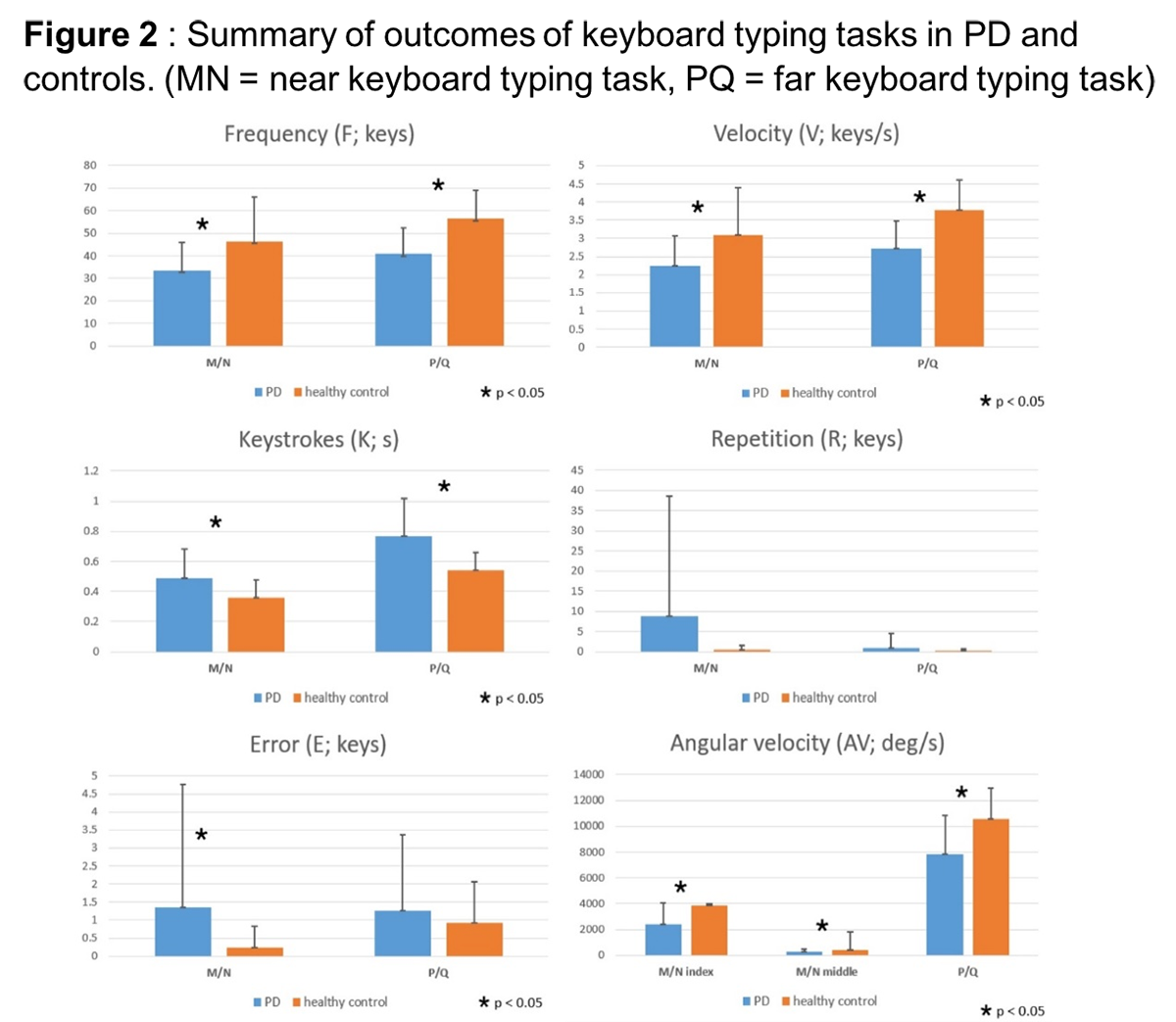Session Information
Date: Tuesday, September 24, 2019
Session Title: Parkinsonisms and Parkinson-Plus
Session Time: 1:45pm-3:15pm
Location: Agora 3 West, Level 3
Objective: To objectively evaluate finger dexterity in Parkinson’s disease (PD) patients by keyboard typing test.
Background: Impaired motor dexterity is a type of bradykinesia which is commonly rated by finger tapping test. However, finger tapping evaluation is frequently subjective, limiting its applications in a screening test of bradykinesia.
Method: 50 PD patients and 50 age-matched healthy controls were recruited in this pilot study. Subjects with poor finger dexterities due to non-neurological causes (e.g. joint deformities) were excluded. Objective evaluation of finger dexterity was assessed by two in-house wearable sensors, placed on the dorsum of index and middle fingers of their most affected side by PD. To determine typing performance, two paradigms were conducted, including side-by-side typing where M/N keystrokes were measured and far-reach typing where P/Q keystrokes were evaluated. The tests were performed during the ‘off’ period in all PD patients, together with standard rating scales. Objective outcomes include typing frequency (F; keys), typing velocity (V; keys/s), keystrokes (K; s), repetition of keyboard tapping (R; keys) and typing error (E; keys).
Results: PD patients had a mean H&Y stage of 1.9 (0.6), with a mean UPDRS III of 23 (10.2), indicating a mild disease severity. Typing F and V were significantly higher in controls compared with PD in both the side-by-side (M/N) and far-reach (P/Q) keyboard typing. (p <0.01 respectively) The duration of each keystroke (K) was significantly longer in PD than control subjects for both tasks (p <0.01). The number of error in PD affected hand was greater than healthy control in only side-by-side (M/N) typing (p = 0.02). Duration of K was positively correlated with UPDRS III in both side-by-side (M/N) task and the far-reach (P/Q) task. (r=0.33, p=0.02, r= 0.36, p=0.01). H&Y stage was negatively correlated with typing velocity only in the far-reach (P/Q) task (r=-0.31, p=0.03).
Conclusion: Our pilot study demonstrated the feasibility of finger sensors on keyboard typing in the objective evaluation of impaired finger dexterity in PD as manifested by slower typing velocity, longer keystroke duration, higher number of errors than control subjects. Impaired finger dexterity was correlated with disease severity and stage of disease. Objective keyboard typing test is a promising test for screening in the future.
To cite this abstract in AMA style:
P. Panyakaew, K. Duangjino, R. Bhidayasiri. Detection of impaired finger dexterity by objective keyboard typing test in Parkinson’s Disease: A feasibility study [abstract]. Mov Disord. 2019; 34 (suppl 2). https://www.mdsabstracts.org/abstract/detection-of-impaired-finger-dexterity-by-objective-keyboard-typing-test-in-parkinsons-disease-a-feasibility-study/. Accessed December 13, 2025.« Back to 2019 International Congress
MDS Abstracts - https://www.mdsabstracts.org/abstract/detection-of-impaired-finger-dexterity-by-objective-keyboard-typing-test-in-parkinsons-disease-a-feasibility-study/



